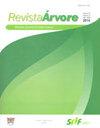OCCUPATION STRATEGY OF THE ARBOREAL SPECIES Tachigali rubiginosa (MART. EX TUL.) OLIVEIRA-FILHO: EVIDENCE OF FOREST EXPANSION OVER GRASSLAND AREAS.
IF 0.8
4区 农林科学
Q4 FORESTRY
引用次数: 0
Abstract
ABSTRACT Understanding the dynamics of forest species occupation in savanna and grasslands environments allows us to assess how forest expansion operates over time. For eleven years, the population dynamics of Tachigali rubiginosa (Mart. ex. Tul.) Oliveira-Filho was registered to evaluate the occupation strategy of this species in the ecotone between forest (Mata de Galeria) and grassland (Campo Sujo), located within the Capetinga stream basin, at Fazenda Água Limpa, Federal District. This area has been protected from wildfires since 1987. This study allocated thirty-one transects of 5 m x 100 m perpendicularly to the Capetinga stream, covering forest and grassland environments. The measurements were taken from adult trees (DBH ≥ 5 cm), young trees (height > 1 m and DBH < 5 cm) and seedlings (height ≤ 1 m and DBH < 5 cm). The results indicated that, in the studied period, the population of T. rubiginosa increased from 179.5 to 262.8 ind / ha. In 2007, of the total of 280 individuals in 1.56 ha, 96 of them were in the forest (0.22 ha), 103 in the ecotone (0.16 ha), and 81 in the grassland (1.18 ha). In 2018, this proportion changed when the number of individuals decreased in the forest (83 individuals), while the number increased in the ecotone (135 individuals) and in the grassland (194 individuals). In 2007, the young trees dominated with 71% of the total, followed by the adults trees (28.5%) and the seedlings (20.7%). In 2018, the young trees represented most individuals (39.2%), but there was a balance between the three size categories, as the seedlings represented 30.0% and adults trees 30.7%. Over the period of the study, there was an increase in the population of T. rubiginosa, especially of young individuals, which indicates persistence over time and an expansion of this forest species into grassland environments.树栖物种褐斑塔奇利的占领策略。例图)。Oliveira-filho:森林在草原地区扩张的证据。
了解稀树草原和草原环境中森林物种占用的动态,使我们能够评估森林扩张是如何随时间变化的。近11年来,研究了红腹大蠊的种群动态。例图)。Oliveira-Filho在联邦区Fazenda Água Limpa的Capetinga河流域的森林(Mata de Galeria)和草地(Campo Sujo)之间的过渡带进行了登记,以评估该物种的占领策略。自1987年以来,该地区一直受到保护,不受野火的影响。本研究在Capetinga溪流垂直方向布置了31个5米× 100米的样带,覆盖了森林和草地环境。测量对象为成树(胸径≥5 cm)、小树(胸径< 5 cm)和树苗(胸径< 5 cm,树高≤1 m)。结果表明:研究期间,绿僵菌种群数量由179.5个/ ha增加到262.8个/ ha;2007年,在1.56 ha地区共有280只,其中森林96只(0.22 ha),过渡带103只(0.16 ha),草地81只(1.18 ha)。2018年,这一比例发生了变化,森林个体数量减少(83只),而过渡带个体数量增加(135只),草地个体数量增加(194只)。2007年以幼树为主,占总数的71%,其次是成树(28.5%)和幼苗(20.7%)。2018年,幼树占大多数个体(39.2%),但三种大小类别之间存在平衡,因为幼苗占30.0%,成年树占30.7%。在研究期间,红毛柽柳种群数量有所增加,尤其是年轻个体,这表明随着时间的推移,这种森林物种向草原环境扩展。
本文章由计算机程序翻译,如有差异,请以英文原文为准。
求助全文
约1分钟内获得全文
求助全文
来源期刊

Revista Arvore
FORESTRY-
CiteScore
1.00
自引率
0.00%
发文量
32
审稿时长
4-8 weeks
期刊介绍:
A Revista Árvore é um veículo de comunicação científica da Sociedade de Investigações Florestais – SIF. O jornal é de acesso gratuito, revisado por pares, que publica bimestralmente trabalhos científicos originais no campo da Ciência Florestal. As áreas temáticas para publicação são: Ambiência e Conservação da Natureza, Manejo Florestal, Silvicultura e Tecnologia da Madeira e Utilização de Produtos Florestais.
A política editorial visa manter alta conduta ética em relação à publicação e aos seus funcionários, rigor na qualidade dos artigos científicos, seleção de revisores qualificados, respeito profissional aos autores e processo de tomada de decisão imparcial. A Revista Árvore publica artigos apenas em inglês.
Artigos de revisão podem ser publicados se houver uma discussão relevante resumindo o estado da arte sobre o assunto. A revisão estrita da literatura não é aceita.
 求助内容:
求助内容: 应助结果提醒方式:
应助结果提醒方式:


